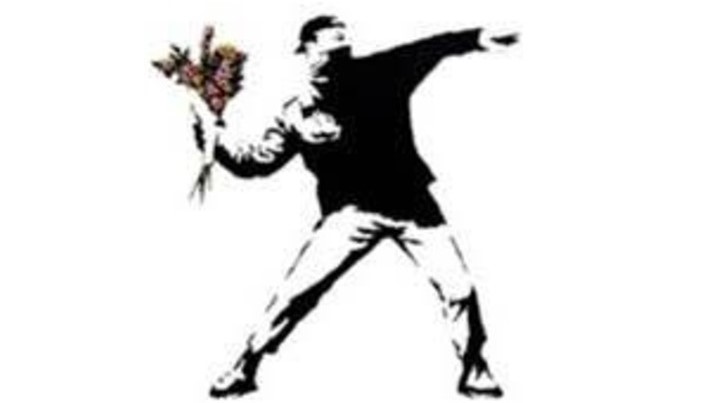November 4, 2020
The primary purpose of registered trade marks is to allow consumers to identify the commercial origin of goods or services. They are not registrable merely as a way of preventing others from registering or using a mark which the Proprietor does not plan to use as a trade mark. Such an application is made in bad faith and the trade mark can be revoked for that reason.[1]
The case demonstrates how the words and actions of a trade mark Proprietor and its principal – here, the famous artist Banksy – can be their own undoing, when responding to a ‘bad faith’ attack.
In 2014, “Pest Control Office” (the Proprietor, and by relation, the well-known graffiti artist, Banksy) registered the figurative mark represented below as a European Union Trade Mark (EUTM) in relation to goods and services in a number of classes. The mark is a reproduction of the “Flower Thrower” image.
In 2019, Full Colour Black, a British-based company, selling mainly greeting cards featuring graffiti artworks (the Applicant), applied for a declaration of invalidity of the EUTM on the grounds of bad faith.
Banksy’s famous Flower Thrower image appeared on the side of a garage in Jerusalem, Israel, in 2005. While Banksy may acknowledge that a work is his, he himself remains anonymous.
The Flower Thrower image was used on the cover of Banksy’s 2006 book entitled ‘Wall and Piece’, in which Banksy asserted that “copyright is for losers”. Banksy has always encouraged use of his works for non-commercial purposes and has not enforced copyright in the image, saying that to do so would be likely to affect his anonymity which would prejudice his persona.
The Applicant claimed that in the light of this the sole purpose of registering the EUTM was to prevent ongoing unauthorised use of the Flower Thrower image, given his inability to rely on copyright law.
The Proprietor, in contrast, argued that a party that registers a trade mark in pursuit of a legitimate objective to prevent another party from taking advantage by copying the sign which is the subject of the registration is not acting in bad faith.

It appears the EUIPO’s decision rested mostly on one central piece of evidence – the launch of Gross Domestic Product, an online and offline shop, which offered, online only, and subject to conditions, various products, such as t-shirts and mugs, incorporating old and new pieces of art by Banksy. The Flower Thrower image appears in the shop in the form of three fragmented pieces of canvas. The evidence included clear statements from Banksy and his legal representative, that the shop had been opened with the sole purpose of proving intent to use and to “make stuff for the sole purpose of fulfilling trademark categories under EU law” (https://shop.grossdomesticproduct.com/).
The EUIPO agreed that the Proprietor registered the mark in question in bad faith. It found that Banksy had no intention to use the EUTM in relation to the contested goods and services at the time of filing of the EUTM. Banksy had only begun using the sign after the application for a declaration of invalidity by the Applicant. The EUIPO held that his intention in doing so was not to use the mark to indicate origin or to carve out a portion of the commercial market, but only to circumvent the law. These actions were inconsistent with honest practices. They showed that his intention was to obtain an exclusive right for purposes other than those falling within the functions of a trade mark. That meant that the trade mark had been filed in bad faith.
The case is an interesting one – it appears that the statements of the Proprietor, that the store was only opened for the purposes of defending the application for revocation, (rather than as a commercial intention to use the mark), tipped the decision in favour of the Applicant. From a trade mark perspective, it does not appear that the mark was at all used in the course of trade per se, or is at all used as a trade mark, since it can be seen on Banksy’s online shop that the only item sold with the image of the “Flower Thrower” is indeed a piece of wall art, which is described as “Banksy™ Thrower”. Whilst that may be perceived of use of the name Banksy as a trade mark, it is not use of the image as a trade mark, and certainly not in all of the classes registered for.
More importantly, unless the decision is overturned following an appeal, this could mean that similar cancellation actions can be undertaken against some or all of Banksy’s other trade mark registrations of his art pieces, of which there are about 12 EUTMs.
The Cancellation Division of the EUIPO has taken quite a direct view, some may call it even a harsh view, towards Banksy, by asserting that obtaining a trade mark registration through an incorporated company is not a ‘legitimate objective’ and is an application in bad faith, when the purpose behind the registration is to stop a party taking advantage of a sign when that party knows that the owner of the sign cannot enforce unregistered trade mark rights and copyright without prejudicing his public persona or business interests. It is perhaps odd that the outcome would have been different if Banksy had made genuine use of the mark, however little.
[1] European Union Intellectual Property Office CANCELLATION No 33 843 C (INVALIDITY) – Banksy’s Flower Thrower
Expertise